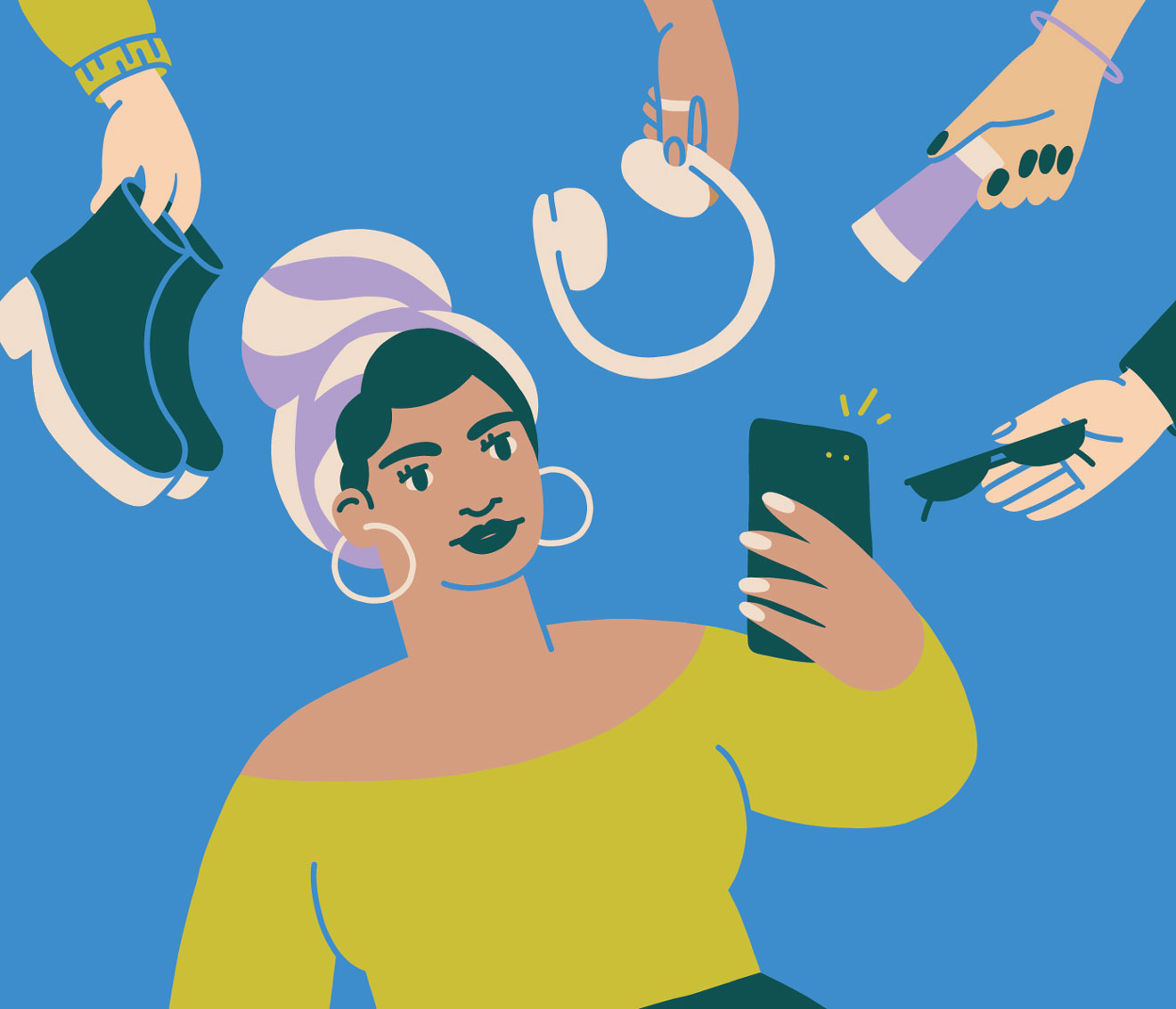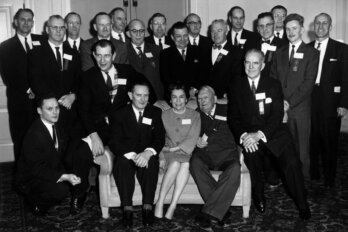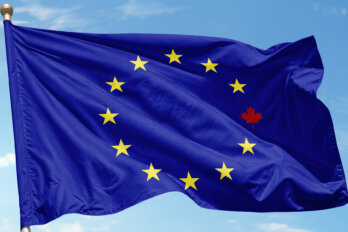In 1932, Lester Gaba set out to create the ideal woman. His aim was simple: she would be beautiful but attainable, a figure that the everyday person could see themselves in. Gaba named his creation Cynthia. Though Cynthia was technically a mannequin—one commissioned by Saks Fifth Avenue—Gaba started bringing her out into the world, treating her like a real person at all times.
Listen to an audio version of this story
For more audio from The Walrus, subscribe to AMI-audio podcasts on iTunes.
Cynthia quickly became a quasi celebrity. She was a regular sight at parties and events and was even photographed for a Life magazine feature. Companies, sensing an opportunity to capitalize on the attention, started sending her their products. “She received free dresses from Saks, diamonds from Tiffany’s, tickets to the Metropolitan Opera,” said journalist Roman Mars on an episode of the design podcast 99% Invisible. “When she showed up in tabloids, she was wearing designer clothes.” Cynthia may not have been sentient, but she was a trendsetter; her brief time as a socialite-cum-advertiser also foreshadowed the world of social media influencers who dominate Instagram feeds and marketing campaigns today.
Like Cynthia, social media influencers aren’t usually celebrities, at least not in the traditional sense. They tend to be regular people—often young, often attractive—who have turned posting pictures or videos to YouTube, Instagram, Snapchat, or TikTok into jobs. For just about any niche or hobby, whether it’s travel, fashion, video games, or fishing, there’s an influencer posting about it on a daily (or hourly) basis, amassing a large and loyal following. Companies have taken note, and they are buying access to these audiences in exchange for merchandise and cash.
This new realm of influencer marketing is less than ten years old, but it’s become a central strategy for certain sales departments because, unlike more traditional formats, such as television spots and billboards, influencer posts are advertisements that don’t feel like ads. Up until the past couple of years, most paid-for posts weren’t even labelled as such. Still, despite the new best practice of noting “#ad” or “#sponsored” in captions, the intimacy of social media means that, for the audience, it can still feel like the influencer just had to let everyone know that they love a particular makeup brand, or a pricey pair of headphones, or, in the case of Kim Kardashian West, a new appetite-suppressing weight-loss product. Canon, Starbucks, Volvo, H&M, the tourism board of Nova Scotia: all have used influencer marketing in recent campaigns. According to Business Insider’s 2019 Influencer Market Report, companies are projected to spend $15 billion on the field by 2022.
Still, influencer marketing on social media is a new business model, and the tactic of throwing money at young personalities and hoping it translates into sales has led to some not-so-surprising results. In 2018, megainfluencer Luka Sabbat (then with 1.4 million followers) was sued for failing to fulfill a $60,000 deal that required him to wear Snapchat’s new product, Snap Spectacles, at high-end fashion shows. (Sabbat had agreed to a minimum of four Instagram posts that included the product; he uploaded only two.) The effectiveness of influencers was further questioned last May, when Instagram star @Arii (then with 2.5 million followers) launched her own clothing line and sold fewer than thirty-six shirts.
It’s failures like these that Bryan Gold is trying to prevent. Gold, a twenty-seven-year-old entrepreneur, is the co-founder and CEO of #Paid, a pioneering Toronto-based software company that deals in influencers. #Paid exists somewhere between talent agency and ad agency—it doesn’t directly manage influencers, but it’s positioning itself as a professional middleman that can work with big businesses to develop and oversee social media campaigns while wrangling the thousands of young social media users who have the desired captive audiences.
Gold knows that influencers have a checkered reputation: despite the value they offer brands, they can be inexperienced and unpredictable, making them potential threats to companies’ images. But the roster that works for #Paid, he explains, is different from the rest. For one, his nearly 22,000 social media stars aren’t mere influencers, he insists—they’re creators.
I trip on this bit of semantics again and again over the few days I spend at the #Paid office—a contemporary open space complete with the requisite startup perks of LaCroix sparkling water and a Ping-Pong table. Each time “influencers” leaves my mouth, I earn a stern look. The difference between the two, various staff members explain to me, is that, unlike typical influencers, #Paid creators care about what they do. They are discerning about whom they’ll work with. (Gold tells me that, when his company received a shipment of a weight-loss product, they sent it right back.) I’m told that, whenever a #Paid creator embarks on a campaign—with, say, Coca-Cola or Uber Eats—the result is an authentic expression of how they feel about the product; the relationship is about more than just making money. “A lot of the creators I spoke with wanted to use their influence for good,” Gold tells me. “They were genuinely passionate about making a difference in the world and making the world a better place.”
While soda endorsements and food-on-demand probably won’t change society for the better, recent trends seem to show that influencer marketing is the future that’s coming for us all: one where social media becomes work, the work never stops, and all online identities are commodities to be constantly managed.
Around 2013, Gold noticed that a friend, Ronnie Friedman, was becoming popular online. Friedman had been building a steady following by posting her fitness journey, sharing healthy meals, before-and-after body shots, and gym selfies. “She was creating awesome content,” Gold says. “Her audience would buy anything she used in order to get fit.” Companies must have noticed this too, as some started reaching out to ask if she’d be interested in posting their products. Friedman hadn’t planned on turning her social media presence into a small business and was stuck trying to manage these deals on her own. Gold saw an opportunity. In 2014, he secured a place in Ryerson University’s startup incubator and officially launched #Paid with co-founder Adam Rivietz. In 2018, the company raised $9 million in venture funding.
The goal of #Paid isn’t to sign big-name celebrity influencers, like reality-television star Kylie Jenner (164 million Instagram followers, net worth reportedly $1 billion US), or massive YouTube stars, like Logan Paul (20.5 million subscribers, estimated net worth $19 million US). Gold built #Paid for people like Friedman: everyday social media users who had carved out a modest following in a particular niche. Many of these users are classified as “microinfluencers,” who tend to have at least 5,000 followers and up to 100,000. The company also acts as a safety net for brands by vetting creators via an algorithm to ensure their followers are real. One thousand fake followers can be bought for a little more than $10, and cybersecurity firm Cheq reported that this kind of fraud was projected to cost advertisers more than $1 billion in 2019.
When it’s time to run a campaign, #Paid puts together a shortlist of potential creators from the around the world for clients. Each creator has tags describing them and their audience, which help companies find the right fit for their target demographics (e.g., “mom,” “single,” “interested in cars”). Once a creator has been selected and has agreed to the partnership, they conceive and execute their own post and upload it onto #Paid’s platform—essentially a mock-up of an Instagram post—for client approval. The two sides go back and forth if necessary, retaking shots and tweaking captions until everyone is happy. The smallest details matter: the #Paid office features a “trending word chart,” a white piece of Bristol board where employees keep track of ever-shifting online slang, which helps ads abide by the zeitgeist. Hours of work go into a single post that most viewers will scroll past and internalize within seconds.
Unlike the less reputable players in influencer marketing, #Paid makes sure that all of its creators’ ad posts are clearly marked as advertisements and follow necessary government regulations. Once a post goes live, the #Paid team goes into analytic overdrive, examining the engagement metrics provided by Instagram (mostly data on likes and comments). It has also partnered with the market research firm Neilson to create sets of statistics that show the effectiveness of its work, tracking a post from app to online cart to purchase. When I visit the office, a projector is displaying the live numbers of a current campaign, showing that an extra $50 ad buy for a sponsored placement on Instagram feeds was leading to $10,000 in sales.
When done right, influencer marketing is a dream for businesses, all high returns on low investments. Creators with #Paid set their own rates: they can make anywhere from tens of dollars to thousands per post, depending on their reach. And, though many small-level influencers won’t make a living from social media, the money isn’t nothing. Meanwhile, #Paid earns its cut by charging clients a monthly fee, which gives businesses a set number of sponsored posts, analytics, and contracts with creators.
In recent years, results have shown that choosing the right influencer for a campaign can be the difference between success and failure; bigger influencers don’t always mean more sales. In an interview with Business of Fashion, Nicolaj Reffstrup, the then CEO of Ganni, a Danish fashion line that relies heavily on influencer marketing, explained that success on social media can be highly unpredictable. Big-name celebrity endorsements sometimes have no effect on sales. “Other times,” he said, “you can have a girl with 4,000 followers in a regional area in Sweden, and she converts to sales extremely well because she makes so much more sense to her followers.”
A recent report from technology-research company Morning Consult found that 56 percent of millennials and Gen Z say that they have made a purchase after seeing a post by someone they follow. Another 86 percent said that they’d be willing to post sponsored content if someone paid them to do so. They may soon get the chance—lately, industry watchers have been promoting a new class of marketing agent: the nanoinfluencer, usually defined as a person with between 1,000 and 5,000 followers. In a few years, everybody on social media may be selling to everybody else.
Digital media has democratized and diffused celebrity, but it seems that many companies buying influencers today want a lifelike Cynthia figure: someone safe, someone on brand, someone who, ideally, doesn’t speak for themselves.
Sylvia Jade is the strategy lead at #Paid, and part of her job is to soothe companies’ fears about working with influencers. “I’ve gotten requests from clients to avoid anyone who’s controversial. I’ve been asked to do background checks,” she says. “If we’re presenting a roster, they can’t be associated with any bad press.”
This kind of digital panopticon has become part of Jade’s own life: in addition to being a #Paid staffer, she’s a beauty YouTuber with more than 180,000 followers. Jade tells me that she’s always highly conscious whenever she leaves her house, careful to look put together and happy. She avoids small expressions of negative emotion, like getting visibly annoyed with her boyfriend while waiting in line for lunch. It’s too risky; she never knows who will recognize her. It seems that normal people can now have all the negative trappings of celebrity with a small fraction of the money and power that usually comes with it.
At first, this level of artifice can be difficult to square with influencers’ main selling point: their authenticity. The word crops up repeatedly when speaking with influencers and the companies that represent them, but its meaning seems to have undergone a shift from its traditional usage. Authenticity among influencers is not about living in a manner that’s true to oneself. Instead, it describes anything that feels true to the audience.
Take @LilMiquela, an Instagram influencer with 1.9 million followers. Miquela is a pretty, freckled woman who looks to be in her early twenties. She’s recently partnered with Ugg and Calvin Klein for sponsored posts and is often pictured hanging out with friends, travelling, and promoting social justice causes. Miquela is also completely fake, a CGI avatar who, like Cynthia nearly ninety years earlier, feels just real enough: fans can see themselves in her, and companies can have complete control over her. She is all artifice but always authentic; a gold standard for mortal influencers everywhere.




